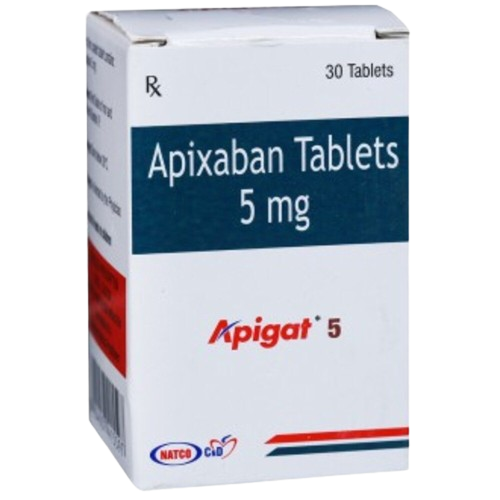“Apixaban 5 mg Tablets: Uses, Dosage, Side Effects, and Safety Profile”
🟦 Apixaban Tablets 5 mg – Full Drug Monograph
Dosage Form: Oral tablet
Strength: 5 mg (also available in 2.5 mg)
🔬 Mechanism of Action
Apixaban selectively inhibits Factor Xa, a key enzyme in the coagulation cascade responsible for converting prothrombin to thrombin. By blocking Factor Xa, apixaban reduces thrombin generation and fibrin clot formation, thus preventing or treating blood clots.
Unlike warfarin, apixaban does not require routine INR monitoring, and it acts independently of Vitamin K.
💊 Indications (Uses)
Apixaban 5 mg is prescribed for the following conditions:
- Prevention of stroke and systemic embolism in patients with non-valvular atrial fibrillation (AF).
- Treatment of deep vein thrombosis (DVT) and pulmonary embolism (PE).
- Prevention of recurrent DVT and PE following initial treatment.
- Prophylaxis of DVT after hip or knee replacement surgery (usually at lower dose, e.g., 2.5 mg).
📏 Dosage and Administration
✅ Standard Dosing (Apixaban 5 mg)
- Non-valvular Atrial Fibrillation:
5 mg twice daily
✅ Dose reduction to 2.5 mg BID if 2 of the following are present:
- Age ≥80 years
- Body weight ≤60 kg
- Serum creatinine ≥1.5 mg/dL
- Treatment of DVT/PE:
10 mg twice daily for 7 days, then 5 mg twice daily - Secondary prevention of DVT/PE:
2.5 mg twice daily after at least 6 months of treatment - DVT prophylaxis after orthopedic surgery:
2.5 mg twice daily starting 12–24 hours after surgery
Important: Take with or without food. Consistency is key for effectiveness.
⚠️ Contraindications
- Active pathological bleeding
- Severe hepatic impairment with coagulopathy
- Hypersensitivity to apixaban or any component of the formulation
⚠️ Warnings and Precautions
- Increased risk of bleeding, especially in elderly or those on other anticoagulants or antiplatelets
- Not recommended in patients with mechanical heart valves
- Caution in renal impairment and hepatic disease
- Spinal/epidural hematoma risk in patients undergoing neuraxial anesthesia or spinal puncture
🔄 Drug Interactions
- Strong CYP3A4 and P-gp inhibitors (e.g., ketoconazole, ritonavir): May increase apixaban levels → bleeding risk
- Strong CYP3A4 and P-gp inducers (e.g., rifampin, carbamazepine): May decrease efficacy
- Other anticoagulants or NSAIDs: Increased bleeding risk
🤰 Use in Pregnancy & Lactation
- Pregnancy: Category B (animal studies show no risk, but no controlled human studies)
Use only if clearly needed. - Breastfeeding: Unknown if excreted in breast milk. Avoid or use alternative.
🧪 Monitoring Parameters
- Routine coagulation testing (INR/PT) is not required
- Monitor for signs of bleeding (gums, bruising, hematuria, GI bleeding)
- Renal function (especially in elderly and those with CKD)
- Liver function if underlying hepatic disorder
❗ Adverse Effects
Common:
- Minor bleeding (nosebleeds, bruising)
- Anemia
- Nausea
Serious:
- Major bleeding (GI, intracranial, internal)
- Thrombocytopenia
- Hypersensitivity reactions (rare)
🧯 Reversal Agent
- Andexanet alfa (Andexxa®) – FDA-approved reversal agent for life-threatening bleeding
- In emergencies, activated charcoal may be used if ingestion was recent
📦 Storage
- Store at room temperature (20–25°C / 68–77°F)
- Protect from moisture and light
- Keep out of reach of children
🌍 Key Benefits of Apixaban (Compared to Warfarin)
- Fixed dosing, no INR monitoring
- Rapid onset of action
- Lower risk of major bleeding (especially intracranial)
- Fewer drug and food interactions
- Effective stroke prevention in AF




Reviews
There are no reviews yet.